weight AUDI A5 COUPE 2018 Owner's Manual
[x] Cancel search | Manufacturer: AUDI, Model Year: 2018, Model line: A5 COUPE, Model: AUDI A5 COUPE 2018Pages: 409, PDF Size: 67.63 MB
Page 344 of 409
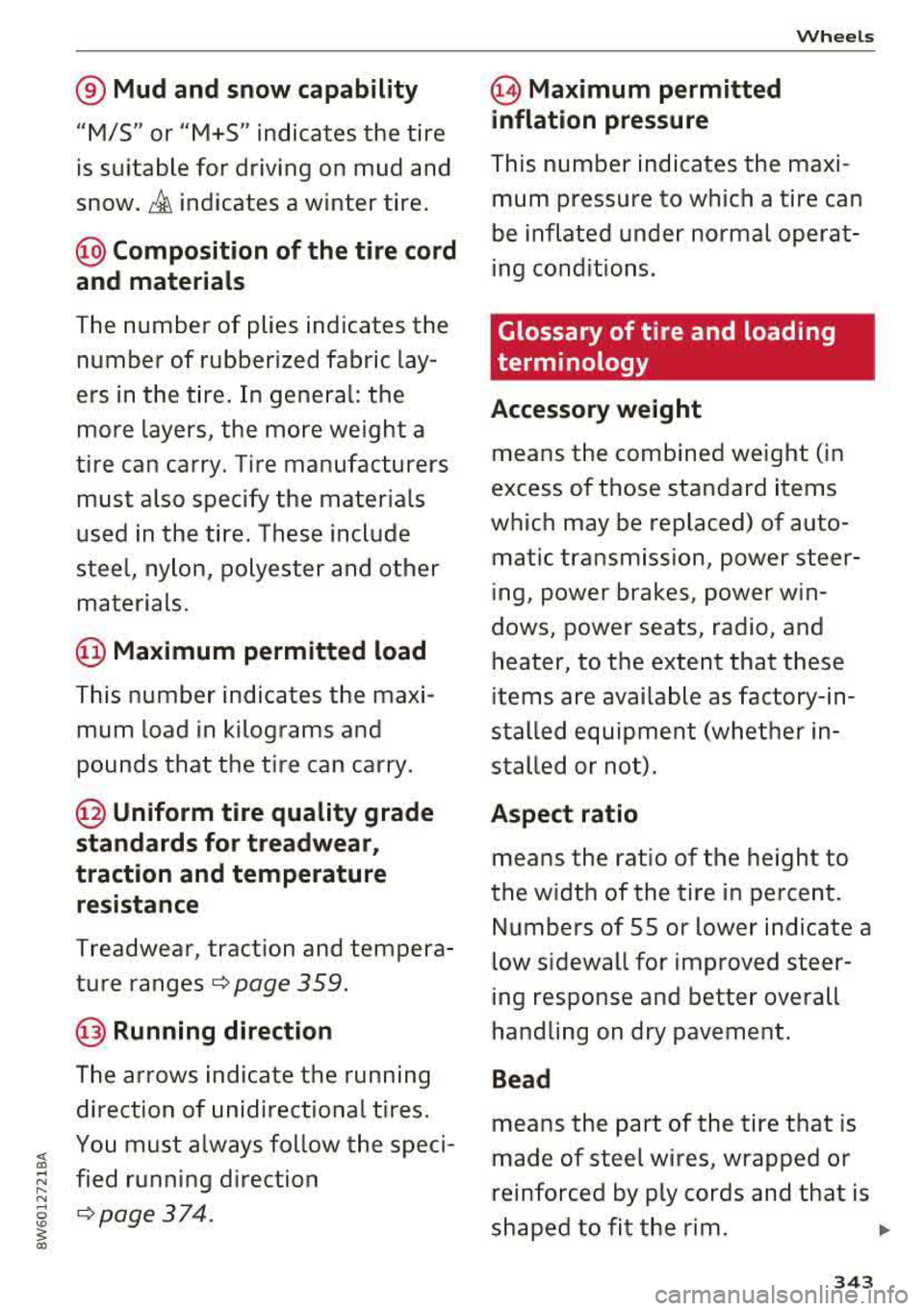
® Mud and snow capability
"M/5" or "M+S" indicates the tire
is suitable for driving on mud and
snow. £ indicates a winter tire.
@Composition of the tire cord
and materials
The number of plies indicates the
number of rubberized fabric lay
ers in the tire . In general: the
more layers, the more weight a
tire can carry. Tire manufacturers must also specify the materials
used in the ti re . These inc lude
stee l, nylon, polyester and other
materials.
@ Maximum permitted load
This number indicates the maxi
mum load in kilograms and
pounds that the tire can carry.
@ Un iform tire quality grade
standards for treadwear,
traction and temperature resistance
Treadwear, traction and tempera
ture
ranges¢ page 359.
@ Running direction
T he arrows indicate the running
direction of unidirectional tires.
You must always follow the speci
fied running direction
¢page 374.
~ Maximum permitted
inflation pressure
Wheels
T his number indicates the maxi
mum pressure to which a tire can
be inflated under normal operat
ing condit ions .
Glossary of tire and loading
terminology
Accessory weight
means the combined weight (in
excess of those standard items
which may be replaced) of auto matic t ransmission, power steer
ing, power brakes, power win
dows , powe r seats, radio, and
heater, to the extent tha t these
items are avai lab le as factory- in
stalled equipment (whether in
s t alled or not).
Aspect ratio
means the ratio of the height to
the w idth of the tire in percent.
Numbers of 55 or lower indicate a
low sidewall for improved steer
ing response and better overall
handling on dry pavement .
Bead
means the part of the tire that is
made of steel wires, wrapped or
reinfo rced by ply cords and that is
shaped to fit the rim.
...
3 4 3
Page 345 of 409
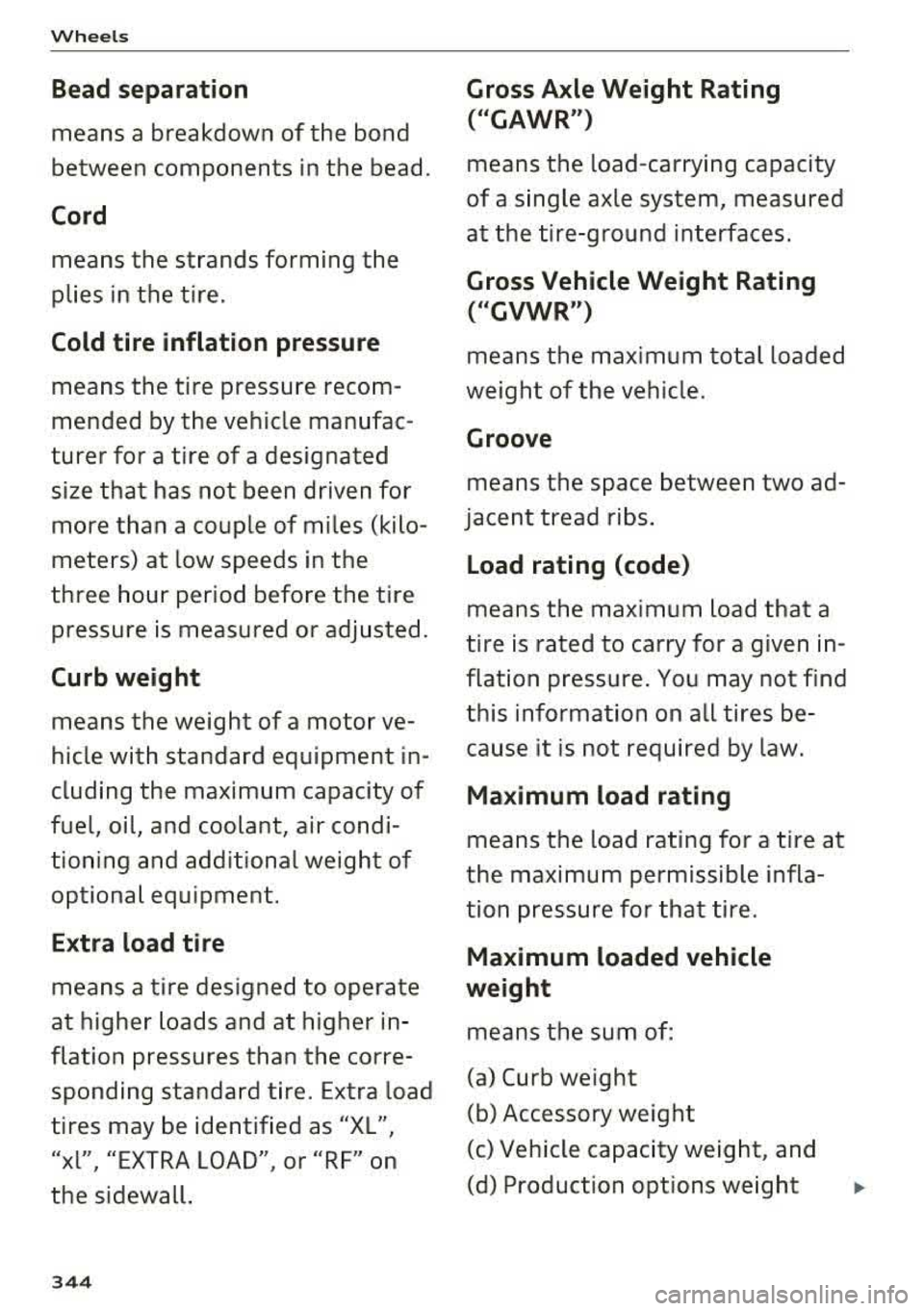
Wheel s
Bead separation
means a breakdown of the bond
between components in the bead .
Cord
means the strands forming the
plies in the t ire.
Cold tire inflation pressure
means the tire pressure recom
mended by the vehicle manufac
turer for a tire of a designated
size that has not been driven for more than a couple of miles (kilo
meters) at low speeds in the
three hour period before the tire
pressure is measured or adjusted.
Curb weight
means the weight of a motor ve
hicle with standard equipment in
cluding the maximum capacity of
fuel, oil, and coolant, air condi
tioning and additional weight of optional equipment.
E x tra load tire
means a tire designed to operate
at higher loads and at higher in
flation pressures than the corre sponding standard tire . Extra load
tires may be identified as
"XL",
"xl", "EXTRA LOAD", or "RF" on
the sidewal l.
344
Gross Axle Weight Rating
("GAWR ")
means the load-carrying capacity
of a single axle system, measured
at the tire -ground interfaces .
Gross Vehicle Weight Rating
(" GVWR ")
means the maximum total loaded
weight of the vehicle .
Groove
means the space between two ad
jacent tread ribs .
Load rating (code )
means the maximum load that a
tire is rated to carry for a given in
flation pressure. You may not find
this information on all tires be
cause it is not required by law.
Ma ximum load rating
means the load rating for a tire at
the maximum permissible infla tion pressure for that tire.
Ma ximum loaded vehicle
weight
means the sum of :
(a) Curb weight
(b) Accessory weight
(c) Vehicle capacity weight, and
(d) Production options we ight
Page 346 of 409
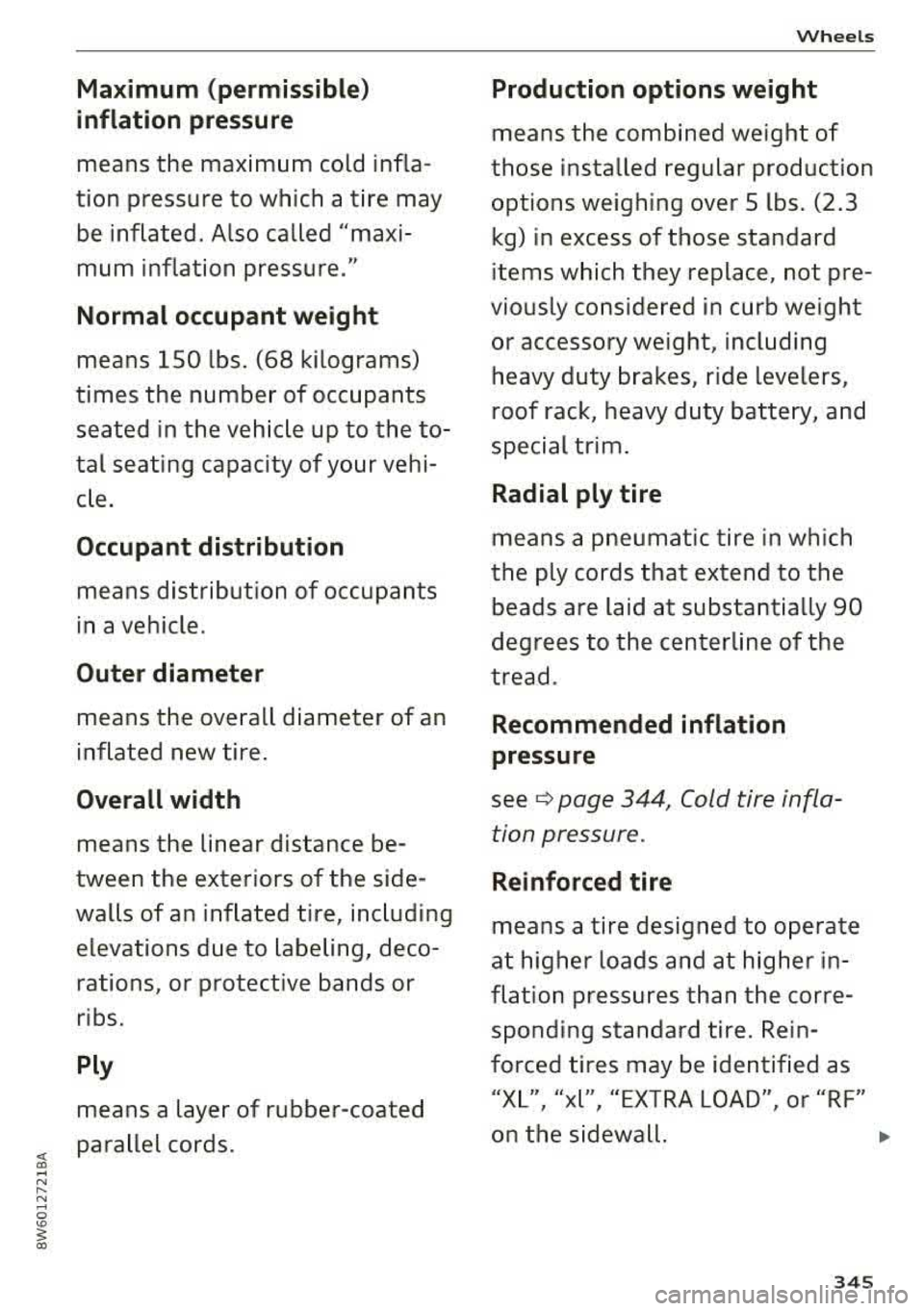
Maximum (permissible )
inflat ion pressure
means the maximum cold infla
tion pressure to wh ich a t ire may
be inflated . Also called "maxi
mum inflation pressure ."
Normal occupant weight
means 150 lbs . (68 kilograms)
times the numbe r of occupants
seated in the veh icle up to the to
tal seating capacity of your vehi
c le .
Occupant distribution
means distribution of occupants
in a vehicle .
Outer diameter
means the overall diameter of an
inflated new tire .
Overall width
means the linear dis ta n ce be
tween the exteriors of the side
walls of an inflated tire, inc luding
e levations due to labeling, deco
rations, or protect ive bands or
ribs.
Ply
means a layer of rubber-coated
parallel cords .
Wheels
Production options weight
means the combined weight of
those installed regular production
options weighing over 5 lbs. (2.3 kg) in excess of those standard
items which they replace, not pre
viously considered in curb weight
or accessory weight, including
heavy duty brakes, ride levelers,
roof rack , heavy d uty ba tte ry , and
special trim .
Radial ply tire
means a pneumatic tire in which
the ply cords that extend to the
beads are laid at substantia lly 90
degrees to the centerline of the
tread .
Recommended inflation
pressure
see ¢ page 34 4, Cold tire infla
tion pressure .
Reinforced tire
means a tire designed to operate
at higher loads and at higher in
fl at ion pressures than the corre
sponding standard tire. Rein
forced tires may be identified as
"X L", "x l", "EXTRA LOA D", or "RF"
on the s idewa ll.
..,
3 45
Page 348 of 409
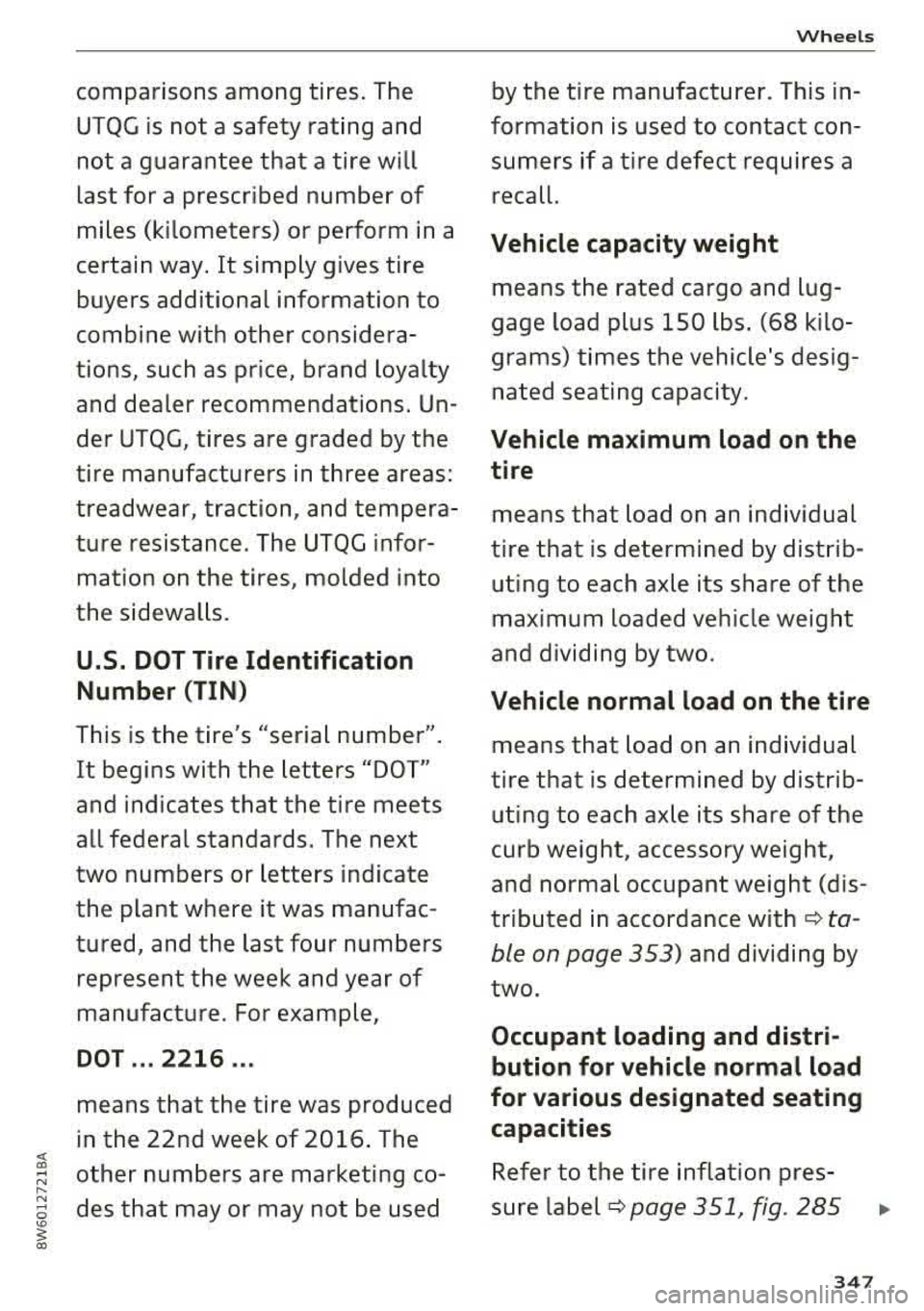
Wheels
comparisons among tires. The by the tire manufacturer. This in-
UTQG is not a safety rating and formation is used to contact con-
not a guarantee that a tire will sumers if a tire defect requires a
last for a prescribed number of recall.
miles (kilometers) or perform in a
Vehicle capacity weight
certain way . It simply gives tire
means the rated cargo and lug-
buyers additional information to
gage load plus 150 lbs. (68 ki lo -
combine with other considera -
tions, such as price, brand loyalty grams) times the vehicle's desig-
na ted seating capacity.
and dealer recommendations. Un-
der UTQG, tires are graded by the
Vehicle maximum load on the
tire manu facturers in three areas: tire
treadwear, traction, and tempera -
means that load on an individual
ture resistance. The UTQG infor- tire that is determined by dist rib-
mation on the tires, molded into
uting to each ax le its share of the
the sidewalls. maximum loaded vehicle weight
U.S. DOT Tire Identification an d div id in g by two.
Number (TIN)
Vehicle normal load on the tire
This is the tire's "seria l number" .
means that load on an individual
It beg ins with the letters "DO T"
tire that is determined by distrib-
and indicates that the tire meets uting to each axle its share of the
all federal s tandards. The next
curb weight, accessory weight,
two numbers o r letters indicate
and normal occupant weight (dis-
the plant where it was manufac- tributed in accordance with
¢ ta-
tu red , and the last four numbers ble on page 353) and divid ing by
represent the week and year of two.
manufactu re . For example,
Occupant loading and distri -
DOT ... 2216 ... bution for vehicle normal load
means that the tire was produced for various designated seating
in the 22nd week of 2016 . The capacities
~
"' other numbers are marketing co- Refer to the tire
inflation pres -..-< N ..... N des that may or may not be used sure label¢ page 351, fig. 285 ..-< ... 0
"' 3'; a:,
3
4 7
Page 356 of 409
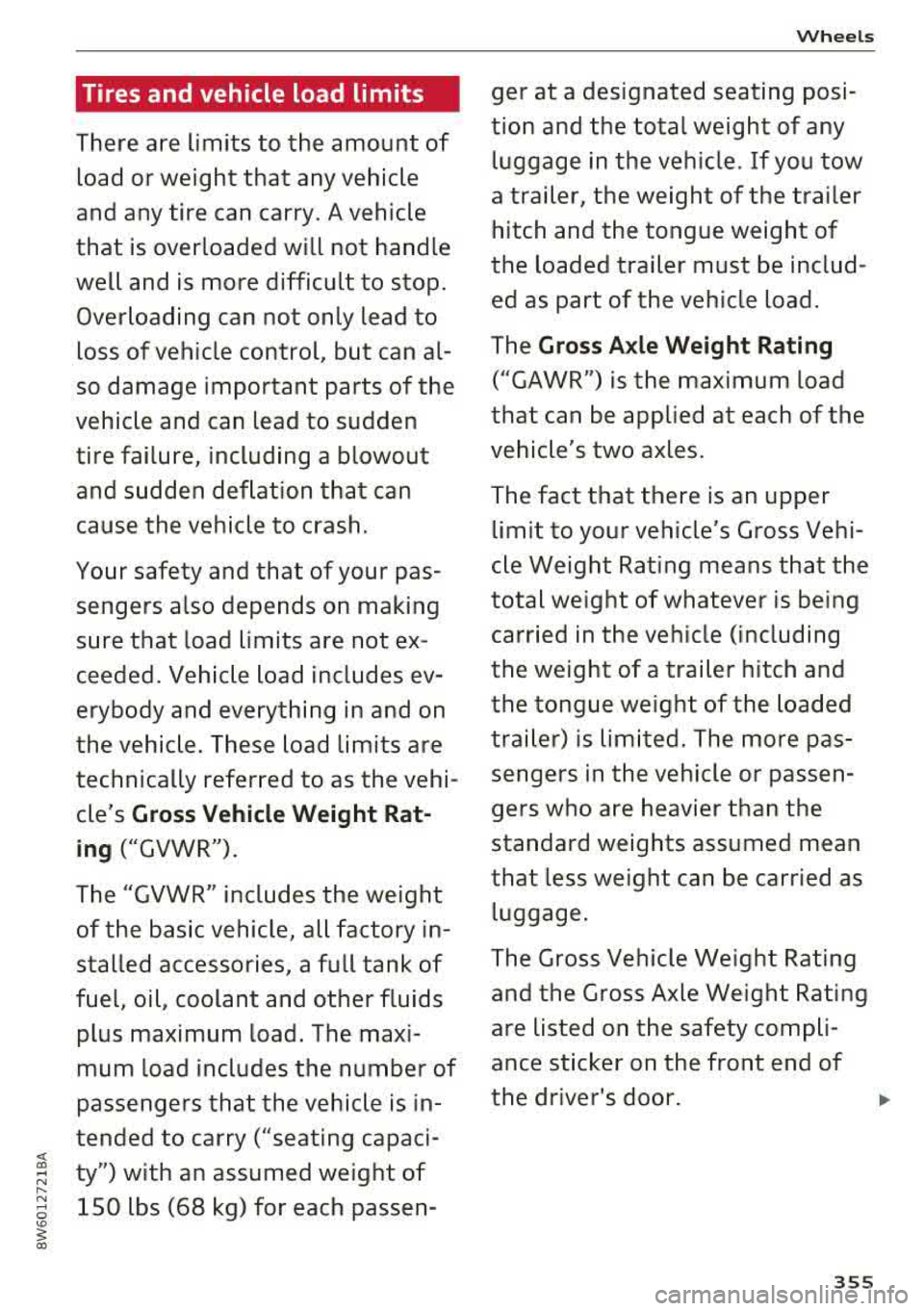
Tires and vehicle load limits
There are limits to the amount of load or weight that any vehicle
and any tire can carry . A vehicle
that is overloaded will not handle
well and is more difficult to stop. Overloading can not only lead to
loss of vehicle control, but can al
so damage important parts of the
vehicle and can lead to sudden
tire failure, including a blowout
and sudden deflation that can
cause the vehicle to crash.
Your safety and that of your pas
sengers also depends on making
sure that load limits are not ex
ceeded. Vehicle load includes ev
erybody and everything in and on
the vehicle. These load limits are
technically referred to as the vehi
cle's
Gross Vehicle Weight Rat
ing
("GVWR").
The "GVWR" includes the weight
of the basic vehicle, all factory in
stalled accessories, a full tank of
fuel, oil, coolant and other fluids
plus maximum load. The maxi
mum load includes the number of
passengers that the vehicle is in
tended to carry ("seating capaci
ty") with an assumed weight of 150 lbs (68 kg) for each passen-
Wheels
ger at a designated seating posi
tion and the total weight of any luggage in the vehicle . If you tow
a trailer, the weight of the trailer
hitch and the tongue weight of
the loaded trailer must be includ
ed as part of the vehicle load.
The
Gross Axle Weight Rating
("GAWR") is the maximum load
that can be applied at each of the
vehicle's two axles.
The fact that there is an upper limit to your vehicle's Gross Vehi
cle Weight Rating means that the
total weight of whatever is being
carried in the vehicle (including
the weight of a trailer hitch and
the tongue weight of the loaded
trailer) is limited. The more pas
sengers in the vehicle or passen
gers who are heavier than the
standard weights assumed mean
that less weight can be carried as luggage.
The Gross Vehicle Weight Rating and the Gross Axle Weight Rating
are listed on the safety compli ance sticker on the front end of
the driver's door.
355
Page 357 of 409
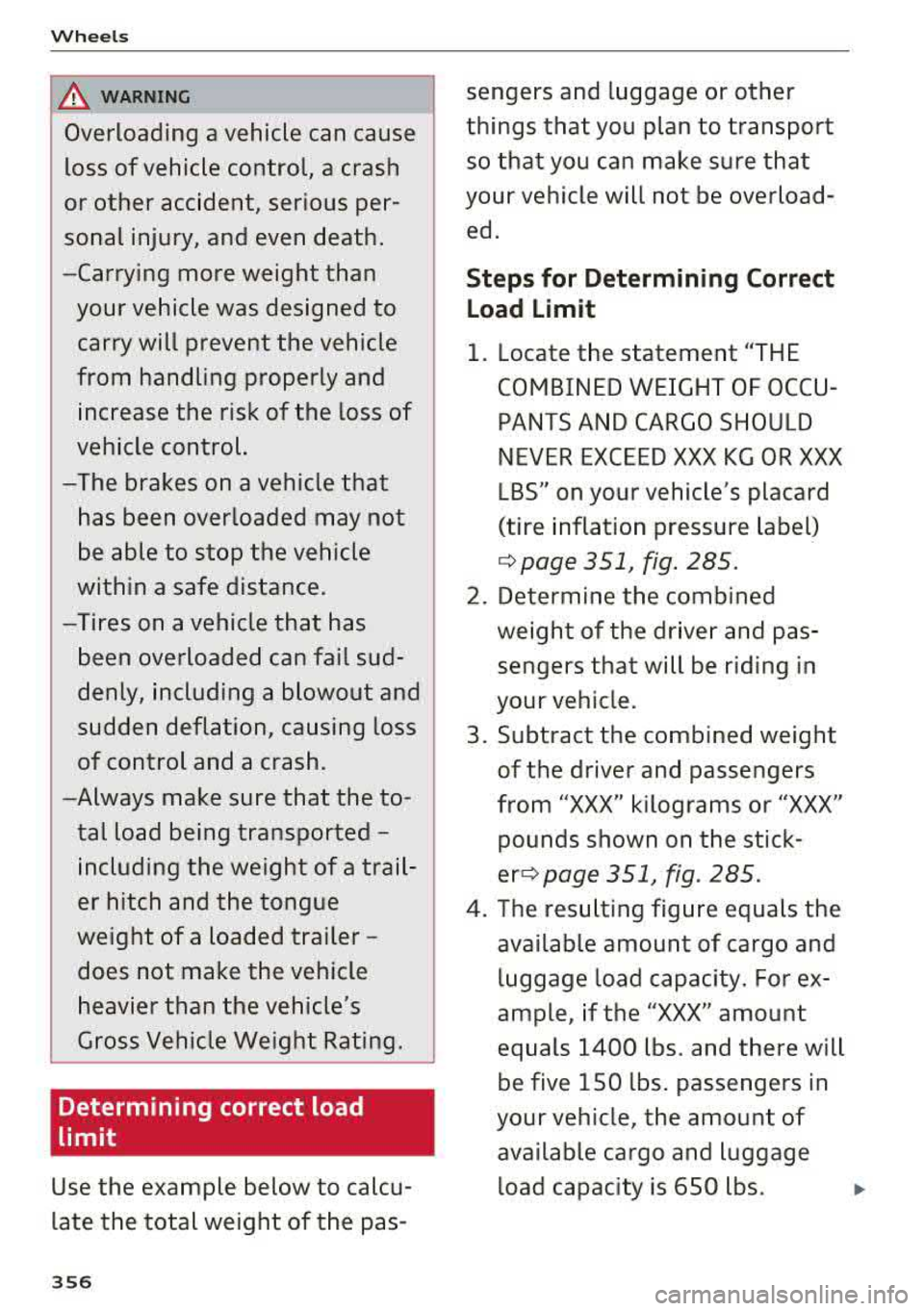
Wheels
A WARNING
Overloading a vehicle can cause
loss of vehicle control, a crash
or other accident, serious per
sonal injury, and even death.
-Carrying more weight than your vehicle was designed to carry will prevent the vehicle
from handling properly and
increase the risk of the loss of
vehicle control.
-The brakes on a vehicle that
has been overloaded may not
be able to stop the vehicle
within a safe distance.
-Tires on a vehicle that has
been overloaded can fail sud
denly, including a blowout and
sudden deflation, causing loss
of control and a crash.
-Always make sure that the to
tal load being transported
-
includ ing the weight of a trail
er hitch and the tongue
weight of a loaded trailer
-
does not make the vehicle
heavier than the vehicle's
Gross Vehicle Weight Rating.
Determining correct load
limit
Use the example below to calcu
late the total weight of the pas -
356
sengers and luggage or other
things that you plan to transport so that you can make sure that
your vehicle will not be overload
ed.
Steps for Determining Correct Load Limit
1. Locat e the statement "THE
COMBINED WEIGHT OF OCCU
PANTS AND CARGO SHOULD
NEVER EXCEED XXX KG OR XXX
LBS" on your vehicle's placard
(tire inflation pressure label)
Q page 351, fig. 285.
2.
Determine the combined
weight of the driver and pas
sengers that will be riding in
your vehicle.
3. Subtract the combined weight
of the driver and passengers
from
"XXX" kilograms or "XXX"
pounds shown on the stick
erQ page 351, fig. 285.
4. The resulting figure equals the
available amount of cargo and luggage load capacity. For ex
ample, if the "XXX" amount
equals 1400 lbs . and there will
be five 150 lbs. passengers in
your vehicle, the amount of
available cargo and luggage load capacity is 650 lbs.
.,.
Page 386 of 409
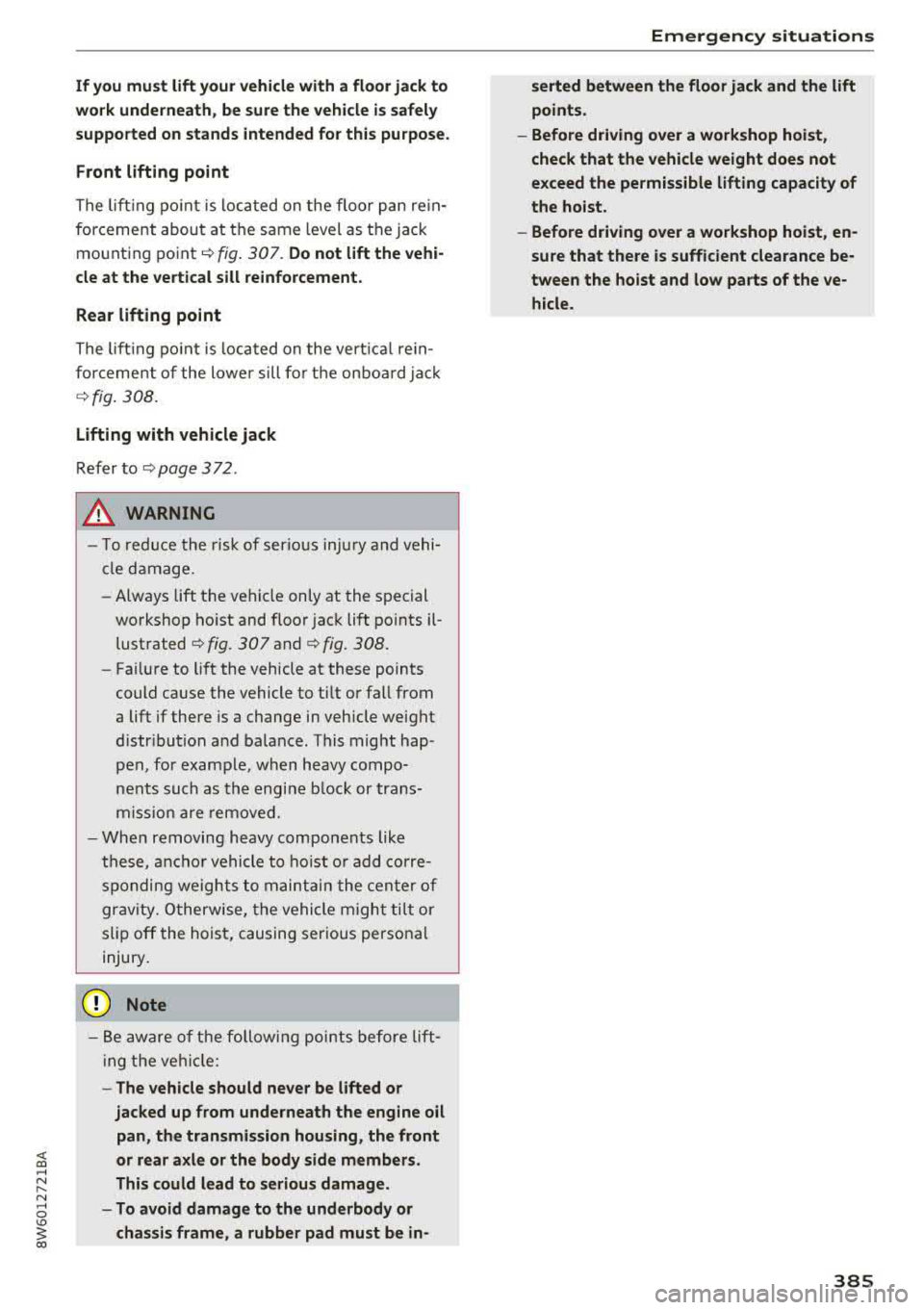
<( a, .... N ,....
N .... 0 \0
3 a,
If you must lift your vehicle with a floor jack to
work underneath , be sure the vehicle is safely
supported on stands intended for this purpose .
Front lifting point
The lifting p oint is loc ated on the floo r pan rein
fo rcement abou t at the same leve l as t he ja ck
mo unt ing poin t ¢
fig . 307. Do not lift the vehi
cle at the vertical sill reinforcement.
Rear lifting point
The lift ing po int is located on the ve rt ical rein
for ceme nt o f the lower s ill fo r th e on bo ar d jac k
¢fig . 30 8.
Lifting with vehicle jack
Refer to ¢ page 372 .
A WARNING
- To reduce the risk of serio us inju ry and vehi
cl e d am age.
- Always lift t he ve hicl e only at the s pecial
wo rkshop ho ist and floo r jack lift po ints il
lustrated¢
fig. 3 0 7 and ¢ fig. 308.
-Fa ilur e to li ft the vehicle at these poin ts
could cause the vehicle to ti lt or fall from
a lift if there is a chang e in vehicle weight
d istr ibut ion a nd balance. This might hap
pen, for exa mp le, when heavy co mpo
n e nts su ch as th e e ngi ne block or tra ns
m is sion are rem ove d.
- W hen removing he avy compon ents like
th ese, an chor vehicle to ho is t or add co rre
s po nding we igh ts to ma inta in t he cente r of
g ra vity. Otherwise, the vehi cle mi ght t ilt or
s lip off the hoi st, causing ser ious persona l
injury .
{U) Note
- Be aware o f the follo wing po ints b efore lift
i n g t he ve hicle:
-The vehicle should never be lifted or
jacked up from underneath the engine oil
pan, the transmission housing, the front
or rear axle or the body side members .
This could lead to serious damage.
- To avoid damage to the underbody or
chassis frame, a rubber pad must be in-
Emergency situations
serted between the floor jack and the lift
points .
- Before driving over a workshop hoist ,
check that the vehicle weight does not
exceed the permissible lifting capacity of
the hoist.
- Before driving over a workshop hoist , en
sure that there is sufficient clearance be
tween the hoist and low parts of the ve
hicle.
385
Page 387 of 409

Technical data
Technical data
Vehicle specifications
Fig. 309 Windshiel d (fro nt left) : Ve hicl e Iden tific ation
N um ber ( VIN )
XXXXX XX -X -XXXX XXX XX
@-+ ~J:~t::1 ::: xxxxxxxx xx x xxxxxxxx
I YP lf'VPE XXX XXX
XX XXXXXXX XX X X XX
XXX
KW XXX
15\_L I MOIOlll
@-+ ~~
1
:tr:~i XXXX I XXXX XXX I XX
II. -AUSST . / OPTIONS
.__ __
E0A 7D5 4UB
2EH JOZ lLB
3FC
F0 A 9G3
TL6 3 KA 8EH
lXW 803
7T6 CV7 7KO
3L4 4KC
lS A 7GB
6XM SSG
lAS
SMU 7Xl
0G7 0YH
UlA X9B
908 8Z4
4X3 2K2
3Y0 413
01A
SRW
1BA
OJF
027
020
502
4G0
XX X XX X XX X XXXX
Fig. 310 Vehi cle identification label
Vehicle Identification Number (VIN) in the
Infotainment system
~ Select in the Infotainment system: the I MENU I
button > Vehicle > left contro l button > Service
& checks> Vehicle information.
Vehicle Identification Number (VIN)
The VIN can be found in the Infotainment sys
tem, on the vehicle data label, and under the
windshield on the front left side* <=:>
fig. 309. The
VIN is also in the right side of the luggage com
partme nt.
386
Vehicle identification label
The vehicle identification label <=:> fig. 310 is locat
ed in the luggage compartment under the cargo
floor cover.
The information of the vehicle identification label
can also be found in your Warranty
& Mainte
nance booklet.
The st icker contains the follow ing vehicle data:
(D Vehicle Iden tifica tion Number (VIN)
@ Vehicle type, eng ine output, transmission
® Engine and transmission cod es
@ Paint and interior codes
® Optional equipment numbers
Safety compliance sticker
The safety compliance sticker is your assurance
that your new veh icle complies with all applicable
Federal Motor Vehicle Safety Standards which
were in effect at the time the vehicle was manu
factured. You can find this sticker on the front
e nd of the dr iver's door. It shows the month and
y ear of production and the vehicle identification
number of you r vehicle (perforation) as well as
the G ros s Vehicle Weight R ating (GVWR) and the
Gro ss Axle We ight Rating (GAWR).
H igh voltage warning label
The high voltage warn ing label is located in the
e ngine compartment next to the engine hood re
lease. The spark ignit ion system complies w ith
the Canadian s tand ard IC ES-002.
Notes about technical
data
The values may vary based on special equipment
as well as market-specific equipment and meas u ring methods.
Please note that the specifications listed in the
vehicle documentation a lways take precedence .
(D Tips
Missing technical data was not available at
the time of printing .
Page 388 of 409
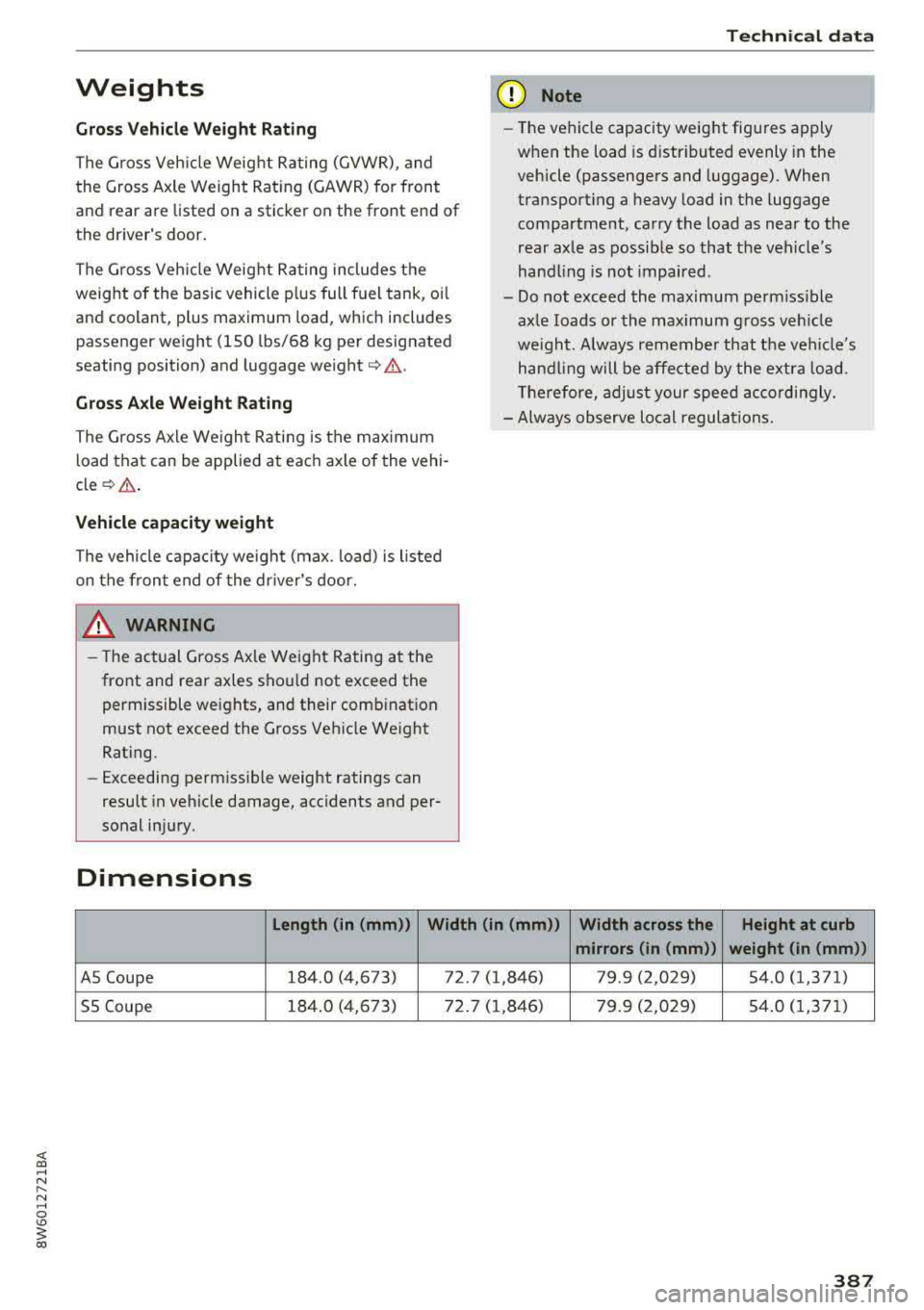
<( a, .... N ,....
N .... 0 \0
3 a,
Weights
Gross Vehi cle We ight Rating
The G ross Veh icle Weight Rating (GVWR), and
the Gross Axle Weight Rating (GAWR) for front
and rear are listed on a sticker on the front end of
the driver's door.
The G ross Veh icle Weight Rating includes the
weight of the basic vehicle p lus full fuel tank, oi l
and coolant, plus maximum load, which includes
passenger weight (150 lbs/68 kg per designated
seating position) and luggage weight
c:> A .
Gross Axle Weight Rating
The Gross Axle We ight Rating is the max imum
l oad that can be applied at each axle of the vehi
cle
c:> A .
Vehicle capacity weight
The vehicle capac ity we ight (max. load) is listed
on the front end of the dr iver's door.
& WARNING
-
- T he act ual Gross Ax le Weight Rating at the
front and rear axles sho uld not exceed the
permissible weights, and their combination
must not exceed the Gross Vehicle We ight
Rating.
- Exceedi ng perm iss ible weight ratings can
result in vehicle damage, acc idents and per
sonal injury.
Dimensions
Techn ical data
(D Note
- The vehicle capacity weig ht figures apply
when the load is d istributed evenly in the
vehicle (passengers and luggage). When
transport ing a heavy load in the luggage
compartment, carry the load as near to the
rear axle as possible so that the vehicle's
hand ling is no t impa ired.
- Do not exceed the maximum perm iss ible
ax le loads or the maximum g ross ve hicle
we igh t. A lways remember that the vehi cle's
hand ling will be affected by the extra load.
T he refore, adjust your speed acco rd ingly.
- Always observe lo cal regulations.
Length (in (mm)) Width (in (mm ))
Width across the Height at curb
mirrors (in (mm )) weight (in (mm))
AS Coupe 184.0 (4,673) 72. 7 (1,846) 79.9 (2,029) 54 .0 (1,371)
55 Coupe 184
.0 (4,6 73) 72 .7 ( 1,846) 79 .9 (2,029) 54 .0 (1 ,37 1)
387
Page 399 of 409
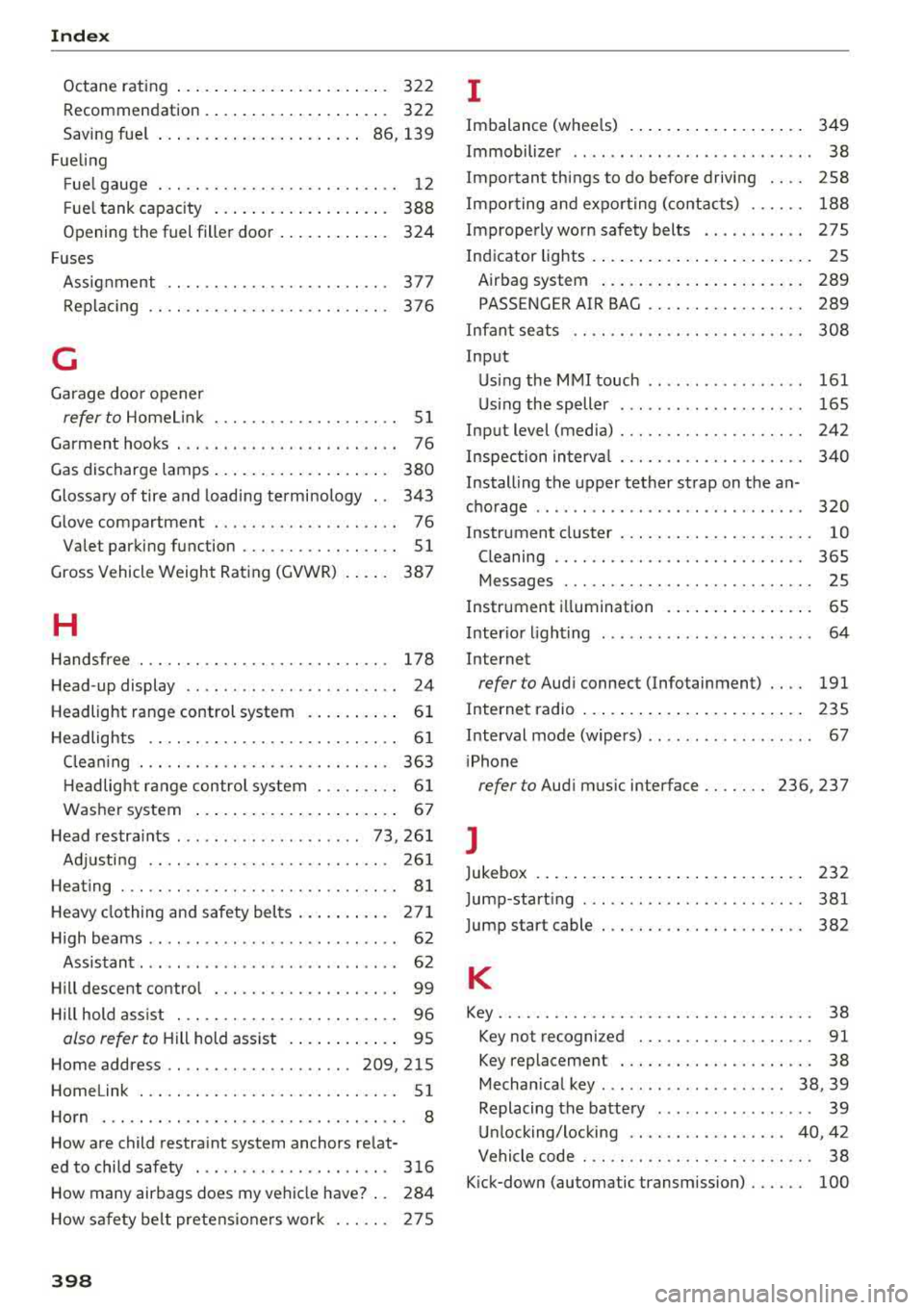
Index
Octane rating . . . . . . . . . . . . . . . . . . . . . . . 322
Recommendation.................... 322
Saving fue l . . . . . . . . . . . . . . . . . . . . . . 86, 139
Fueling Fuel gauge . . . . . . . . . . . . . . . . . . . . . . . . . . 12
F uel tank capacity . . . . . . . . . . . . . . . . . . . 388
Opening the fuel filler door . . . . . . . . . . . . 324
Fuses Assignment . . . . . . . . . . . . . . . . . . . . . . . . 377
Replac ing . . . . . . . . . . . . . . . . . . . . . . . . . . 376
G
Garage door opener
refer to Homel ink . . . . . . . . . . . . . . . . . . . . 51
Garment hooks . . . . . . . . . . . . . . . . . . . . . . . . 76
Gas discharge lamps . . . . . . . . . . . . . . . . . . . 380
Glossary of tire and loading terminology . . 343
Glove compartment . . . . . . . . . . . . . . . . . . . . 76
Valet parking function . . . . . . . . . . . . . . . . . 51
Gross Vehicle Weight Rating (GVWR) . . . . . 387
H
Handsfree . . . . . . . . . . . . . . . . . . . . . . . . . . . 178
Head-up display . . . . . . . . . . . . . . . . . . . . . . . 24
Headlight range control system . . . . . . . . . . 61
Headlights . . . . . . . . . . . . . . . . . . . . . . . . . . . 61
Clean ing . . . . . . . . . . . . . . . . . . . . . . . . . . . 363
Headlight range control system . . . . . . . . . 61
Washer system . . . . . . . . . . . . . . . . . . . . . . 67
Head restraints . . . . . . . . . . . . . . . . . . . . 73, 261
Adjusting . . . . . . . . . . . . . . . . . . . . . . . . . . 261
Heating . . . . . . . . . . . . . . . . . . . . . . . . . . . . . . 81
Heavy clothing and safety belts . . . . . . . . . . 271
High beams . . . . . . . . . . . . . . . . . . . . . . . . . . . 62
Assistant . . . . . . . . . . . . . . . . . . . . . . . . . . . . 62
Hill descent control . . . . . . . . . . . . . . . . . . . . 99
Hill hold ass ist . . . . . . . . . . . . . . . . . . . . . . . . 96
also refer to Hill hold assist . . . . . . . . . . . . 95
Home address .... .. ........ ...... 209, 215
Homelink . . . . . . . . . . . . . . . . . . . . . . . . . . . . 51
Horn . . . . . . . . . . . . . . . . . . . . . . . . . . . . . . . . . 8
How are child restraint system anchors relat-
ed to child safety . . . . . . . . . . . . . . . . . . . . . 316
How many airbags does my vehicle have? . . 284
How safety belt pretens ioners work . . . . . . 275
398
I
Imbalance (wheels) . . . . . . . . . . . . . . . . . . . 349
Immobilizer . . . . . . . . . . . . . . . . . . . . . . . . . . 38
Important things to do before driving . . . . 258
Importing and exporting (contacts) . . . . . . 188
Improperly worn safety belts . . . . . . . . . . . 275
Indicator lights . . . . . . . . . . . . . . . . . . . . . . . . 25
Airbag system . . . . . . . . . . . . . . . . . . . . . . 289
PASSENGER AIR BAG . . . . . . . . . . . . . . . . . 289
Infant seats . . . . . . . . . . . . . . . . . . . . . . . . . 308
Input Using the MMI touch . . . . . . . . . . . . . . . . . 161
Using the speller . . . . . . . . . . . . . . . . . . . . 165
Input level (media) . . . . . . . . . . . . . . . . . . . . 242
Inspection interval . . . . . . . . . . . . . . . . . . . . 340
Installing the upper tether strap on the an -
chorage . . . . . . . . . . . . . . . . . . . . . . . . . . . . . 320
Instrument cluster . . . . . . . . . . . . . . . . . . . . . 10
Cleaning . . . . . . . . . . . . . . . . . . . . . . . . . . . 365
Messages . . . . . . . . . . . . . . . . . . . . . . . . . . . 25
Instrument illumination . . . . . . . . . . . . . . . . 65
Interior lighting . . . . . . . . . . . . . . . . . . . . . . . 64
Internet
refer to Audi connect (Infotainment) . . . . 191
Internet radio . . . . . . . . . . . . . . . . . . . . . . . . 235
Interval mode (wipers) . . . . . . . . . . . . . . . . . . 67
iPhone
refer to Audi music interface ....... 236, 237
J
Jukebox 232
Jump-start ing . . . . . . . . . . . . . . . . . . . . . . . . 381
Jump start cable . . . . . . . . . . . . . . . . . . . . . . 382
K
Key.......... .. .. .. .. .. ........... ... 38
Key not recogni zed . . . . . . . . . . . . . . . . . . . 91
Key replacement . . . . . . . . . . . . . . . . . . . . . 38
Mechanical key . . . . . . . . . . . . . . . . . . . . 38, 39
Replacing the battery . . . . . . . . . . . . . . . . . 39
Unlocking/locking . . . . . . . . . . . . . . . . . 40 , 42
Vehicle code . . . . . . . . . . . . . . . . . . . . . . . . . 38
Kick-down (automatic transmission) . . . . . . 100